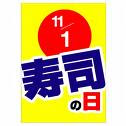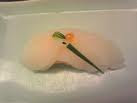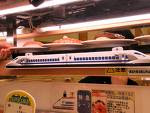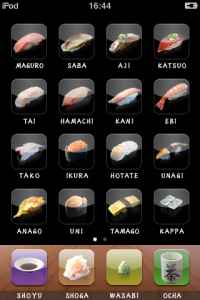[ . BACK to WORLDKIGO TOP . ]
::::::::::::::::::::::::::::::::::::::::::::::::::::::::::::::::::::::::::::::::::::::::::::::::::::
rice crackers (senbei 煎餅)
***** Location: Japan
***** Season: Topic
***** Category: Humanity
*****************************Explanation

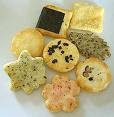
There are many specialities with the name ...
senbei.
Some are made from rice flour, some from
mochigome rice flour and others from wheat flour.
age senbei 揚げせんべい deep-fried crackers
chibimaru senbei ちび丸せんべい, for Chibi Mariko Manga
ebisenbei, ebisen えびせんべい
with shrimp
goma senbei 胡椒せんべい with sesame seeds
haatogata senbei ハート型せんべい shape of a heart
oshiage senbei 押上せんべい
shoyu senbei with soy sauce 醤油せんべい (しょうゆせんべい)
shio senbei with salt 塩せんべい
tai senbei 鯛せんべい with sea bream
teyaki senbei 手焼きせんべい handmade senbei
ebisenbei from shiba-ebi, Aichi prefecture
::::::::::::::::::::::::::::::::::::::::::::::::::::::::::::::::::::::::::::::::::::::::::::::::::::
- - - - - other types are made from glutinous rice:
arare あられ
okaki おかき (御欠き)
kakimochi 欠き餅(もち)
quote
Arare (あられ "hailstones") is a type of bite-sized Japanese cracker made from glutinous rice and flavored with soy sauce. The size and shapes are what distinguish arare from senbei.

There are many different sizes, colors, and shapes of arare. Some are sweet, and others savory. One, called norimaki arare (nori meaning an edible seaweed foodstuff in the form of a dried sheet; maki meaning roll shape) is wrapped with dried nori seaweed. Another, kakinotane (柿の種, kakinotane), takes its name from its resemblance to a persimmon seed. (Kaki is Japanese for "persimmon".) Kakinotane are often sold with peanuts, a combination called kakipī (かきピー, kakipī. These are a popular snack to accompany Japanese beer.
Japanese typically consume arare to celebrate the Doll Festival (Hinamatsuri), on March 3, Girls' Day in Japan. The arare made during the festival are very colorful - pink, yellow, white, brown, light green, and so on. Regular arare can be bought throughout the year, but the colorful ones are only available around January to March in anticipation of the Doll Festival.
© More in the WIKIPEDIA !
. arare ochazuke あられお茶漬 Arare with green tea
from Mie prefecture
- - - - - My Photo Album - - - - -
Senbei
:::::::::::::::::::::::::::::::::::::::::::::::::::::::::::::::::::::::::::::::::::::::::::::::::::
Senbei (irimochi) (煎餅, せんべい)
are Japanese crackers, made from nonglutinous rice. They come in various shapes, sizes, and flavors, usually savory but sometimes sweet. Senbei are often eaten with green tea as a casual snack and offered to visiting house guests as a courtesy refreshment.
Senbei are usually cooked by being baked or grilled, traditionally over charcoal. While being prepared they may be brushed with a flavoring sauce, often one made of shoyu and mirin. They may then be wrapped with a layer of nori. Alternatively they may be flavored with salt or so-called "salad" flavoring.
In China, senbei are called jiānbang (煎餅). There are varieties like Shandong Jianbing and Tianjin Jianbing. However, these are in actuality a different food. In China, they are more like wraps and pancakes, similar to okonomiyaki, whereas in Japan they are hard (not floppy), and are bite-sized snacks rather than meals.
Sweet senbei (甘味煎餅) came to Japan during the Tang dynasty, the first recorded usage in 737 AD, and still are very similar to Tang traditional styles, originally often baked in the Kansai area, of which include the traditional "roof tile" senbei. These include ingredients like potato and wheat flour or glutinous rice, and are similar to castella cakes. (Not like what people most think of senbei today).
What Japanese commonly refer to as sembei nowadays was popularized by a shop in the
Edo Period, Sōkajuku, which spread salty soy sauce flavored sembei throughout Japan.
-
Soka Senbei,
see below -
There are several types of traditional Japanese senbei. They include the 2 categories,
sweet sembei (over 15 types) and
rice candy senbei (米菓煎餅),
and others, which include even fish senbei (魚せんべい), lotus senbei (蓮根煎餅) and bone senbei (骨せんべい) from fish bones.
Modern senbei versions are very inventive and may include flavorings can which range from kimchi to wasabi to curry to chocolate.
Kansai senbei tend to use glutinous rice and have a lightly seasoned and delicate in texture (saku saku). Kantō senbei were originally based on uruchimai, a non-glutinous rice, and they tend to be more crunchy (kari kari) and richly flavored.
© More in the WIKIPEDIA !
. Food vendors in Edo .
senbeiya, senbei-ya 煎餅屋 Sembei shop, Senbei shop
Senbei were very popular in Edo and sold at many shops.
Danjuroo senbei 団十郎煎餅
named after the popular Kabuki actor
Ichikawa Danjuro were especially popular. They were round and imprinted with the family crest of the Danjuro family, the 三升 Mimasu.
Asagao Senbei 朝顔煎餅 / 朝顔せんべい
morning glory rice crackers
were mentioned in the Kabuki play
. Sukeroku yukari no Edo-zakura 助六由縁江戸桜 .
The funny clown actor was named 朝顔仙平 Asagao Senbei. The painting of the actor's face was related to various parts of a morning glory.
 source : kabuki-za.com/syoku
source : kabuki-za.com/syoku
The play has a long monologue about the various uses on
senbei.
senbei zukushi せんべい尽くし
「事もおろかやこの糸びんは砂糖煎餅が孫、羽衣せんべえはおれが姉様、
双六(すごろく)せんべえとは行逢(ゆきあ)い兄弟、姿見煎餅はおらがいとこ、
竹村の堅巻せんべえが親分に、
朝顔仙平という色奴(いろやっこ)様だ」
They were sold by Fujiya Seizaemon.
- reference source : tukitodora.exblog.jp -
and modern
Kabuki Senbei 歌舞伎せんべい

:::::::::::::::::::::::::::::::::::::::::::::::::::::::::::::::::::::::::::::::::::::::::::::::::::
. Kokeshi Senbei こけし せんべい .
:::::::::::::::::::::::::::::::::::::::::::::::::::::::::::::::::::::::::::::::::::::::::::::::::::
Darums Senbei from Maebashi だるま煎餅
前橋の丸福本舗
Gunma Prefecture

七転び八起き
Nanakorobi yaoki
seven times down, eight times up - - - Daruma Lore
八起せんべい Yaoki Senbei



:::::::::::::::::::::::::::::::::::::::::::::::::::::::::::::::::::::::::::::::::::::::::::::::::::
Asakusa Iriyama Senbei shop 入山せんべい

 - reference source : shinise.tv/iriyamasenbei... -
- reference source : shinise.tv/iriyamasenbei... -
:::::::::::::::::::::::::::::::::::::::::::::::::::::::::::::::::::::::::::::::::::::::::::::::::::
Edo Daruma Hakkei 江戸だるま八景
Eight views of Daruma in Edo


Eight different flavors of Daruma Senbei!
だるまの形をした8種類のおせんべい。Nihonbashi Nishiki Horin
- reference source : 日本橋錦豊琳 -
. Hokusai, Great Wave and Tsunami
北斎 津波 .
:::::::::::::::::::::::::::::::::::::::::::::::::::::::::::::::::::::::::::::::::::::::::::::::::::
Fish bones roasted "like senbei",
hone senbei 骨せんべい
If you grill fish at home, you can grill the big bones in a final round to produce your own. They are full of calcium and good for children and the elderly. They are sold as a snack.

Knochen-Kräcker
:::::::::::::::::::::::::::::::::::::::::::::::::::::::::::::::::::::::::::::::::::::::::::::::::::
Ebisenbei from Hokkaido えびせんべい
ebisen えびせん
 source : store.shopping.yahoo.co.jp
source : store.shopping.yahoo.co.jp
かにせん kanisen with crabmeat
わかめせんwakamesen with wakame seaweed
うにせん unisen with sea urchins
えびせんべい・抹茶 ebisenbei macha .. shrimps with green tea
えびせんべい・かぼちゃebisenbei kabocha shrimps .. with pumpkin
えびせんべい・いかすみえびせんebisenbei ikasumi ... with ink from the squidえびせんべい・えびせんべい・わさびせん kawaebi ... with river shrimp
and many more !
Buson-An and Sakura-Ebisen 蕪村菴 さくらえびせんべい
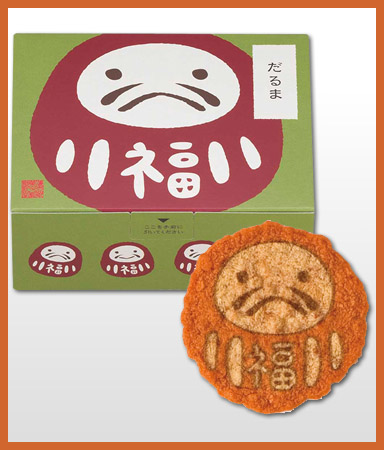
Darume Ebiesn だるま海老せん
桂新堂

「和物」プリントえびせんべい福だるま
.......................................................................
Kappa Ebisen かっぱえびせん
 - quote -
- quote -
Kappa Ebisen (かっぱえびせん) is a Japanese snack food produced by Calbee of Japan in Hatsukaichi, Hiroshima. It is a crunchy, shrimp-flavored snack resembling Krupuk, Indonesian traditional snack food and It became very popular in Japan. The version produced by Calbee America is called Shrimp Flavored Chips.
The primary ingredients of Kappa Ebisen are wheat flour, vegetable oil, starch, shrimp, sugar, salt, baking powder, amino acid and sweetening.
Kappa Ebisen was first produced and sold by Calbee in 1964 and has gained wide popularity among Japanese consumers as a snack food. Its simplicity makes it a popular snack in many settings, and is often a popular choice for karaoke or as a bar snack. ...
- - - More in the WIKIPEDIA !
:::::::::::::::::::::::::::::::::::::::::::::::::::::::::::::::::::::::::::::::::::::::::::::::::::
. Ichiyo Senbei 一葉煎餅(いちようせんべい)
In honor of the poetess Higuchi Ichiyo 樋口 一葉
. Ishida Mitsunari 石田三成 せんべい
In honor of the famous samurai
.................................................................................
Jibachi senbei 地蜂煎餅, 地蜂せんべい
Wasp rice crackers

In Omachi, 120 miles northwest of Tokyo, there is a fan club
Omachi Jibachi Aikokai (Omachi digger wasps lovers group) that has teamed up with a local biscuit maker to create jibachi senbei, or
digger wasp rice crackers.
Elderly wasp hunters from the village, who are mostly in their 80s, catch the insects in nearby forests, boil them in water, dry and sprinkle them over the cracker mix, which is then stamped by hot iron cracker cutters.
Five or six black digger wasps are added to the rice cracker each, clearly visible to the naked eye and while the senior citizens love them, young Japanese see the bugs and refuse to eat the senbei!
source : japansugoi.com
Sold in a bag with 20 pieces.
More about
Konchu Ryori, konchuu ryoori 昆虫料理 Insects as food
:::::::::::::::::::::::::::::::::::::::::::::::::::::::::::::::::::::::::::::::::::::::::::::::::::
- - - - - 18 types of senbei - - - - -
 Imaya Senbei Store, Kanazawa
Imaya Senbei Store, Kanazawa 今屋のおせんべい
burandii senbei, burandei senbei ブランデーせんべい / ブランデー煎餅
senbei with brandy flavor
. . . CLICK here for Photos !
from Tsukui Senbei Shop 津久井せんべい本舗
They even got an official prize 内閣総理大臣賞受賞.
They are normal senbei covered with a layer of flour mixed with real French brandy.
The owner was inspired by whiskey bonbons and tried his family trade, senbei, with various flavors. Now they create 30 different ones for example
koohii senbei 珈琲煎餅 senbei with coffee flavor
wain senbei ワインせんべい wine flavor senbei
There are also wine senbei in memory of
Takeda Shingen from Yamanashi.
武田信玄のワインセンベイ
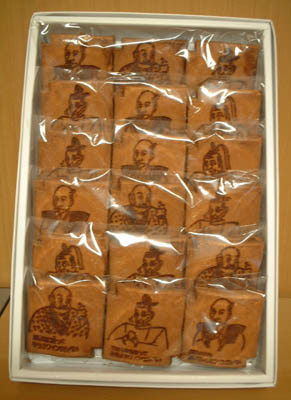
:::::::::::::::::::::::::::::::::::::::::::::::::::::::::::::::::::::::::::::::::::::::::::::::::::::
karee senbei カレーのおせんべい sembei with curry flavor
. . . CLICK here for Photos !
kootsuu anzen senbei 交通安全せんべい
senbei used in campaigns for safe driving
. Masakado Senbei 将門煎餅 .
for Taira no Masakado 平将門 / 平將門 (? – 940)
::::::::::::::::::::::::::::::::::::::::::::::::::::::::::::::::::::::::::::::::::::::::::::::::::::
Nanbu senbei, Nambu senbei 南部せんべい
from Morioka, former Nambu province
Nambu Sembei, waffles from Nanbu
Made from wheat flour, salt and water. The dough is pressed into round waffle molds with long handles and baked over charcoals. The overflowing baked dough is cut off and also sold as "ears"
mimi to put into soup.
They come in variuos flavors. Originated in Hachinohe, where there are many local brands in the shelves of the supermarkets.
. . . CLICK here for Photos !
senbeijiru せんべい汁 senbei soup
Make soup with vegetables, mushrooms and meat and add Nanbu senbei just before eating.
There is a special senbei brand which does not dissolve in hot water.
 senbei aisu
senbei aisu せんべいアイス
Senbei filled with ice cream !
 - - - - - Nambu-Waffeln
- - - - - Nambu-Waffeln
Die berühmten Nambu-Waffeln kommen aus der Stadt Hachinohe, die in der heutigen Präfektur Aomori liegt, einst die Domäne Nambu. Früher dienten die Waffeln als haltbare Nahrungsmittel für die langen Wintermonate.
In den Supermärkten von Hachinohe finden sich endlose Regale mit über 40 Sembei-Sorten, allein zehn davon mit Sesam. Meistens werden sie in kleinen Familienbetrieben von Hand gebacken, sodass jede Sorte ihren einzigartigen Geschmack erhält.
Bei ganz einfachen Waffeln besteht der Teig lediglich aus Weizenmehl, Salz und Wasser. Die Sembei werden in Waffeleisen mit langen Griffen über glühenden Holzkohlen oder in einem elektrischen Heizgerät gebacken. Die Temperatur für Waffeln ohne Füllung sollte 130 °C betragen. Der Bäcker muss darauf achten, sie ständig zu wenden, damit sie nicht anbrennen. Mittlerweile wurden auch spezielle Maschinen zur Waffel-Herstellung entwickelt, die in Kleinbetrieben bis zu 3000 Waffeln täglich backen können. Die Bäcker allerdings müssen stets wachsam sein, da gleichzeitig Teig in die Formen gegossen und Waffeln aus den Formen herausgenommen werden mussen.

Zur Geschmacksverfeinerung wird häufig schwarzer Sesam mitgebacken, der den Waffeln einen unverwechselbar aromatischen Geschmack gibt. Einige Hersteller bestellen das unverzichtbare Salz für den Teig sogar aus den Hochebenen von Tibet, weil dieses Natursalz dank seines Mineralgehaltes dem Gebäck überraschenderweise eine gewisse natürliche Süße verleiht.
Für andere Sorten werden klein gehackte Erdnüsse mit etwas Zucker eingebacken. Andere Mischungen ergeben sich aus Äpfeln und Kürbissen, Süßkartoffeln und Shiso-Blättern. Auch verschiedene Getreidesorten werden beigemischt. Für einen herzhafteren Geschmack kommen Zwiebeln, Sojasauce, Chili, Tintenfisch oder Jakobsmuscheln mit in den Teig.
Der bei der Herstellung am Rand herausquellende Teig wird nicht entfernt, sondern mitgebacken, und in Körben gesammelt. Viele Kunden lieben diese von den Japanern »Ohren« genannten Reststücke als Zutat für die tägliche Suppe. Sie kommen daher auch in den Verkauf. Ebenfalls als Suppenzutat, und zwar für Eintöpfe im Winter
Senbeijiru, werden weiße Sembei gebacken. Sie sind sehr hart und lösen sich im heißen Wasser nur langsam auf. Weitere Zutaten dieses Eintopfs sind Hühnerfleisch, Wintergemüse, Pilze – und alles, was der Familie schmeckt.
:::::::::::::::::::::::::::::::::::::::::::::::::::::::::::::::::::::::::::::::::::::::::::::::::::::
ninniku agesenbei ニンニク揚げせんべい
fried senbei with garlic

from Northern Japan, Fukushima
also with cheese flavor
:::::::::::::::::::::::::::::::::::::::::::::::::::::::::::::::::::::::::::::::::::::::::::::::::::::
Soka senbei, Sooka senbei 草加せんべい
Soka (Sooka), Saitama, a famous senbei city
埼玉県草加市

A Senbei (Rice Cracker) is the traditional confectionery of Soka. There are, however, many people make a mistake that it is Tokyo's specialty product. For this reason, we would like to let you have a correct understanding that how our local special product "Senbei" has been made and has become famous in all over Japan. Also, in February 2006, Soka Senbei was specified as " regional food brand (the genuine product made at the genuine place)", and in June 2007, it was registered as "regional organization trademark". For such the situation, Soka Senbei has been recognized as the brand name nevertheless there are many similar products being manufactured and sold. Here, we would consider how we should make more popular the brand name value of the real genuine "Soka Senbei"
Origin of Soka Senbei
When Town Soka was busy as the post town point on Nikko Kaido (Nikko Highway leading to Nikko) during the era of Edo, Ms "Osen-san" was selling dumpling cakes. One day, under suggestion from a passerby "samurai", she made a sort of Senbei in the shape of a baked rice cracker by crashing dumpling cake to flat and keeping it dry under the sun heat. It has been told that she, then, began making and selling it.
History of Soka Senbei
With regard to the history of our special product "Soka Senbei", we would herein introduce how it has finally become popular all over Japan as follows.
Hard Baked Rice Crackers were changed to Flat Salty Senbei during the era of Edo.
The Soka region was the typical village for cultivation of rice and in order to store surplus rice, people made Senbei, initially called
Kata-Mochi (Hard Rice Cake).
When the Soka Post Town was set up during the era of Edo, there were many teahouses and food shops along with Nikko Kaido Road and this preservative food were being sold to travelers, which finally became very popular. At the early stage, salt was mixed into the Senbei rice cracker, but after the end of Edo era, it changed to put soybean sauce (shoyu) on a flat shaped Senbei after baking. At the beginning, some shops were called Salt Senbei Shops.
Turning Point was when the Senbei was presented to the Emperor
-- Eras of Meiji to Taisho
From the later of Meiji era, Soka Senbei shops had been gradually increased but many of them handled the Senbei as the side job in addition to sell other general merchandizes.
At the time of Taisho (after the era of Meiji), the Japanese army had a comprehensive military practice in Kawagoe and Soka Senbei was presented to Emperor Taisho, who was, then, the general commander of the Japanese army. This fact became the good turning point to expand the Senbei business.
The Soka Senbei was specified and expanded to all over Japan because "the emperor family purchased the delicious senbei". The local Soka Senbei Industry has been established, which was further expanded around that time and begun to enjoy making the product as the Soka's specialty product. It, then, continued making a prosperous progress for expansion.
Time of Sufferings, Glory and Fog
-- From Eras of Showa to Heisei
The Soka Senbei industry had made a good progress when entered to the era of Showa. However, during the Second World War, it had become very difficult time to obtain the material - i.e., rice - due to the severe control by the government on rice, so that many Soka Senbei Manufacturers (shops) had to discontinue the business one by one. Some of them, however, continued business obtaining the rice material somehow under the severe control by the authority (police). That time was the most difficult time for the Soka Senbei industry.
But only the good thing was Soka Senbei Manufactures maintained the manufacturing method (technique) under the dangerous situation (by police and military group). This was very good and lucky because the police authority is controlling rice distribution at the black market very severely, but some shops obtained the material (rice) somehow. Under such situation, the industry kept the traditional technique to make the Senbei, which is now greatly contributed for the industry and the market.
During the time of 1960s, the rice control was discontinued and the industry could follow the way of the high degree economic growth as the same as other main industries. Again, the name of Soka Senbei had been well known through special sales campaigns at department stores and big railway station's shopping areas.
However, in a proportion to rising of the well-known product name as "Soka Senbei", Senbei makers of other regions had begun making similar products even under different production methods. They began selling under the name of Soka Senbei at many places in Japan nevertheless the quality and taste were not good as the genuine Soka Senbei. As the result, although the name of "Soka Senbei" could obtain the good popularity, its reliability was deteriorated and the definition of "Soka Senbei" could badly become vaguely. The tendency has been continued to today.
source : www.city.soka.saitama.jp
:::::::::::::::::::::::::::::::::::::::::::::::::::::::::::::::::::::::::::::::::::::::::::::::::::::
Takabe Jinja Senbei 高家(たかべ)神社煎餅
In honor of the God of Cooking,
God of Iwakamutsukari no Mikoto 磐鹿六雁命
. Tokyo Sky Tree Senbei 東京スカイツリー .
May 22, 2012 - Grand Opening
:::::::::::::::::::::::::::::::::::::::::::::::::::::::::::::::::::::::::::::::::::::::::::::::::::::
Unzen yusenpei ゆせんぺい senbei from hot spring water
Nagasaki, Mount Unzen
. Urashima Taro 浦島太郎 Ebisen えびせんべい .
:::::::::::::::::::::::::::::::::::::::::::::::::::::::::::::::::::::::::::::::::::::::::::::::::::::
 Lucky Waffles with Toys inside, fukutoku senbei 福徳せんべい
Lucky Waffles with Toys inside, fukutoku senbei 福徳せんべい
::::::::::::::::::::::::::::::::::::::::::::::::::::::::::::::::::::::::::::::::::::::::::::::::::::
Yaotsu Senbei 八百津町 せんべい
From Yaotsu Town, Gifu.
They produce about 100 different kinds of senbei with many flavors.
The latest is a huge one of 1 meter diameter, made for events to share with the kids.
sauce yakisoba senbei ソース焼きそばせんべい is loved by younger people.
Senbei as containers of local ice cream, eaten with a senbei formed like a spoon.
. . . CLICK here for Photos !
*****************************
Worldwide use
Reiskräcker, Waffeln, Nanbu-Waffeln
Gebäck
*****************************
Things found on the way
- - - Naschen erlaubt: Sembei
Unter Sembei fasst man in Japan verschiedene Gebäck-, Waffel-, und Kräckersorten zusammen, die entweder aus Reismehl, Mochigome-Klebreismehl oder Weizenmehl gebacken und flach gepresst sind. Sie können süßlich oder salzig schmecken. Eine Sembei-Dose ist in jedem japanischen Haushalt zu finden, denn Sembei bilden das Mindestmaß an Gastfreundschaft. Kommen Gäste ins Haus, wird als erstes grüner Tee gekocht, gleich darauf werden Sembei aus der Dose genommen, auf einem Servierteller angerichtet und vor die Gäste auf den niedrigen Tisch gestellt. Der grüne Tee folgt unverzüglich. Sembei sind nicht nur für Gäste ein beliebter Snack, sondern auch für die ganze Familie. Sie werden zu jeder Tageszeit gegessen.
Das Gebäck gibt es in unzähligen Geschmacksrichtungen mit Sojasauce oder anderen Zutaten gewürzt. Sie sind rund oder viereckig, sternförmig oder wie ein Dachziegel geformt. Am beliebtesten ist die flache, runde Sembei-Sorte aus einfachem Reismehl mit dem Geschmack von Sojasauce. Sie verbreitete sich ab dem 17. Jahrhundert von Edo (heute Tokyo) aus über ganz Japan. Diese Sembei sind besonders knusprig und werden durch weitere Zutaten im Geschmack variiert.
In vielen Städten mit Sehenswürdigkeiten gibt es Geschäfte, die gleich am Ortseingang oder Bahnhof frische Sembei herstellen und einzeln verkaufen. Der verlockende Röstduft zieht die Kunden schon von weitem an, die hier Reisemitbringsel (meibutsu) aus der Gegend erstehen können. In Japan ist es üblich, von einer Reise etwas für die Daheimgebliebenen, insbesondere Arbeitskollegen, mitzubringen. Sehr gern werden Sembei, die zusammen in der Pause genascht werden können, nach einem Urlaub verschenkt.
*****************************
HAIKU
煎餅をいぬがかむ音花の雨
senbei o inu ga kamu oto hana no ame
the sound of senbei
when my dog crunches them...
rain on the cherry blossoms
Hoshino Tatsuko 星野立子
Tr. Gabi Greve
:::::::::::::::::::::::::::::::::::::::::::::::::::::::::::::::::::::::::::::::::::::::::::::::::::::
long autumn rain -
the smell of senbei and
smoked cheese

These senbei, rice crackers, have a very typical smell. They are called
mame mochi with roasted soybeans, from Tokachi, Hokkaido. Each one is wrapped in an extra pouch and when you open one, the rich fragrance of rice emerges from it.
Gabi Greve, September 2009
*****************************
Related words
*****
WASHOKU : General Information
::::::::::::::::::::::::::::::::::::::::::::::::::::
[ . BACK to DARUMA MUSEUM TOP . ]
[ . BACK to WORLDKIGO . TOP . ]
- #senbei #sembei #ricecrackers #kappaebisen #ebisen -
:::::::::::::::::::::::::::::::::::::::::::::::::::::::::::::::::::::::::::::::::::::::::::::::::::::::::::::::::::::::::::





































